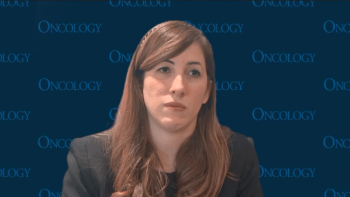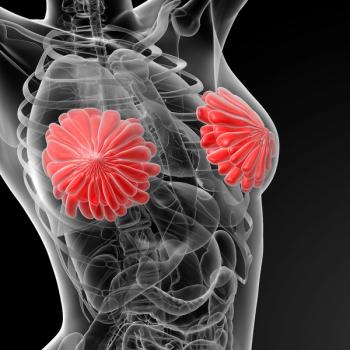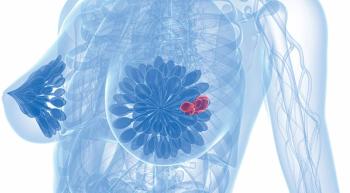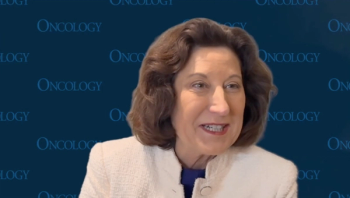
Oncology NEWS International
- Oncology NEWS International Vol 7 No 7
- Volume 7
- Issue 7
Adjuvant Paclitaxel Increases Survival in Early, N+ Breast Cancer
SAN FRANCISCO--Interim results of a major intergroup study of paclitaxel (Taxol) as adjuvant treatment of node-positive breast cancer "will change the standard of care for node-positive breast cancer patients," I. Craig Henderson, MD, of the University of California, San Francisco, said at ASCO.
SAN FRANCISCO--Interim results of a major intergroup study of paclitaxel (Taxol) as adjuvant treatment of node-positive breast cancer "will change the standard of care for node-positive breast cancer patients," I. Craig Henderson, MD, of the University of California, San Francisco, said at ASCO.
The planned interim analysis showed that adding paclitaxel to standard doxorubicin/cyclophosphamide (AC) improved survival, while escalating the doxorubicine dose did not.
Adding paclitaxel "decreased recurrence by 22% and deaths by 26%," Dr. Henderson said. "We have not seen evidence of dose-response for doxorubicin doses over 60 mg/m²."
No previous randomized trial had found an adjuvant chemotherapy regimen more active than AC.
The study randomized 3,170 patients with operable node-positive breast cancer to adjuvant therapy with cyclophosphamide (600 mg/m²) plus one of three doses of doxorubicin (60, 75, 90 mg/m²), with or without paclitaxel (175mg/m² over 3 hours), every 3 weeks for 4 cycles. Patients with estrogen-receptor-positive tumors also had the option of taking tamoxifen (Nolvadex), 20 mg/day for 5 years.
At the time of the interim analysis, there had been 453 recurrences and 200 deaths. At 18 months of follow-up, 90% of patients on AC plus paclitaxel were estimated to be alive and free of recurrence, compared with 86% on AC without paclitaxel (see Table). Overall survival at 18 months was 97% on AC plus paclitaxel vs 95% on AC alone.
Looking at the proportional rather than absolute benefit, paclitaxel was thus responsible for about a 22% reduction in annual odds of recurrence and a 26% reduction in annual odds of death, an effect, Dr. Henderson said, that "may represent the largest increase in benefit for adjuvant therapy since the first CMF trials in the 1970s."
However, he urged that this statement be taken with caution in light of the fact that the data are not mature.
He noted that proportional effects are usually much larger than absolute effects because they are based only on the patients who have recurred in the control arm and those who presumably would have died in the treated arm as well if they had not been treated. "Thus," he said, "in a study of 100 patients where 10 have died in the control arm and 8 in the treated arm, the absolute difference in mortality would be 2%, but the proportional reduction would be 20%."
Although these results are preliminary, Dr. Henderson noted that "in the past, we have found that once we establish a significant reduction in the annual risk of recurrence or death from breast cancer, that remains fairly constant over 10 to 15 years."
The usual toxicities associated with AC were seen. Cardiotoxicity rates were low and did not increase with doxorubicin dose or with addition of paclitaxel. The most common paclitaxel-associated toxicities (grade 3) were transient myelosuppression (21%), neuropathy (5%), pain (5%), and hyperglycemia (5%).
"The sequential addition of paclitaxel to AC as postoperative adjuvant therapy of node-positive primary breast cancer is well tolerated and significantly improves both disease-free survival and overall survival," Dr. Henderson concluded. Long-term analysis will be done to determine the durability of this effect.
Articles in this issue
over 27 years ago
Calling the National Cancer Instituteover 27 years ago
Six Cycles of AT Found Safe in Advanced Breast Cancerover 27 years ago
New Drug Promising in Advanced Pancreatic Cancerover 27 years ago
Herceptin/Chemo Effective in Metastatic Breast Cancerover 27 years ago
Virtual Reality Exhibit Simulates Cancer Fatigueover 27 years ago
New Director of AIDS Researchover 27 years ago
Exhibit Explores Healing Power of Creating Artworkover 27 years ago
Update on Trials of Thrombopoietin for Platelet Recoveryover 27 years ago
Amifostine Reduces Xerostomia After RT for Head and Neck Cancerover 27 years ago
National Survey Documents Gap in Quality of HIV/AIDS CareNewsletter
Stay up to date on recent advances in the multidisciplinary approach to cancer.














































































